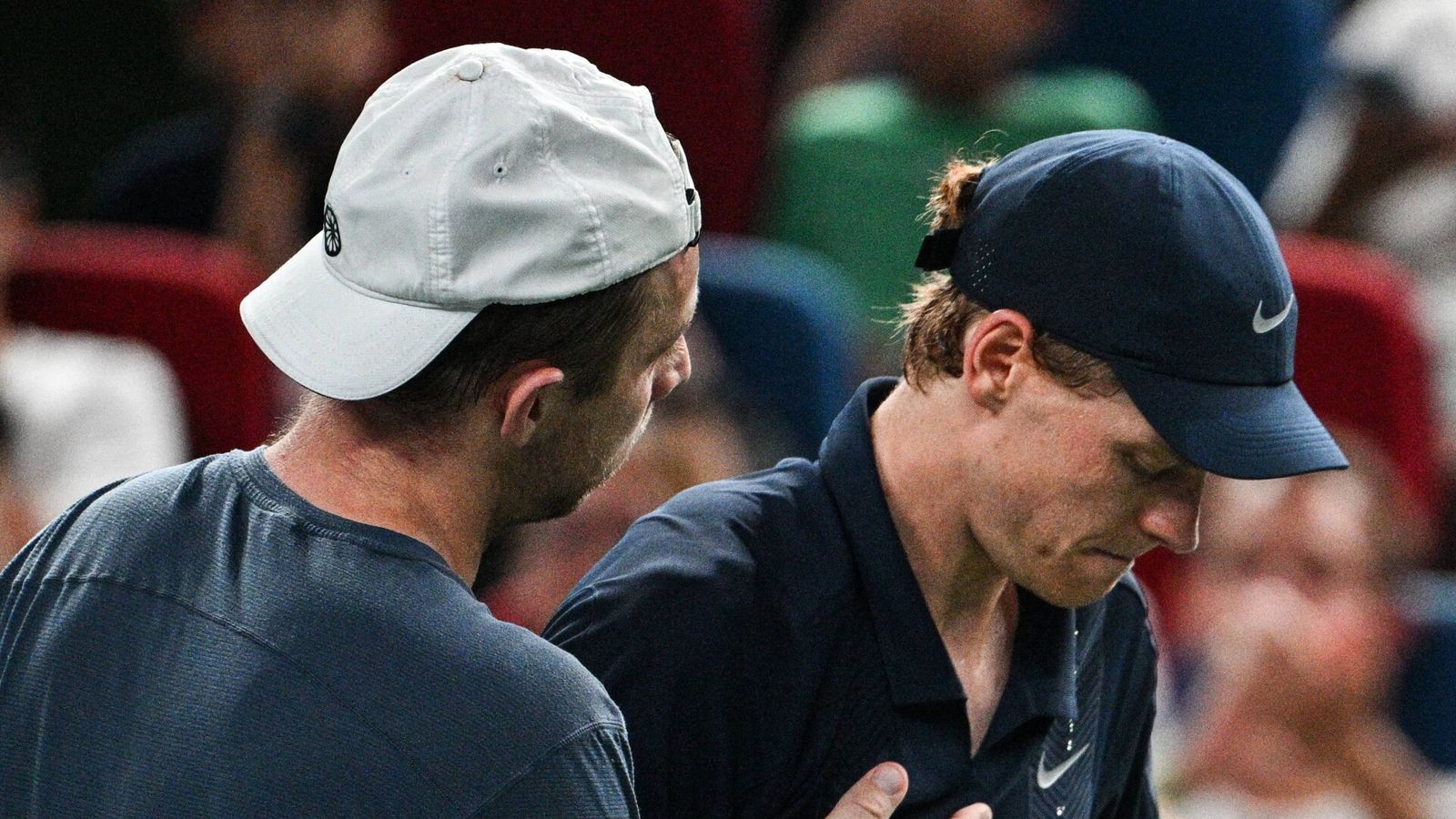
A dozen players have retired mid-match from the ongoing WTA and ATP tournaments in China over the last seven days, highlighting concerns about player welfare.
Temperatures of 35C and high humidity in both Shanghai and to the east in Wuhan have contributed to heavy fatigue, players being sick and cramping in the extreme conditions which are abnormal at this time of year for both cities.
It also raises questions around the tennis schedule with six-time Grand Slam champion Iga Swiatek stating the season is “too long” and “too intense”.
Sportspeople being pushed to their physical limit often makes for great viewing but are things going too far in tennis? Are this week’s events a one-off or do they underline bigger issues which need to be addressed?
‘Worse than losing consciousness’
Ahead of the Shanghai Masters quarter-finals, seven men retired during the match with many others visibly struggling including Novak Djokovic who was sick on Sunday then looked exhausted in his dramatic second-round win over Jaume Munar on Tuesday.
“It’s the same for every player on the court, but it’s brutal,” said Djokovic, who is into the semi-finals in Shanghai, live on Sky Sports Tennis on Saturday morning.
“It’s brutal when you have more than 80 per cent humidity day after day, especially for players who play during the day, in the sun, then it’s even harder. Biologically it’s a bit more challenging for me to deal with it.”
Djokovic added he has been “trying to stay alive on the court” but continues to demonstrate his age is not a limit at 38 years old, the oldest player ever to reach the last four of an ATP 1000 tournament.
But, world No 61 and rising star Terence Atmane was the first player to retire in the first round last Thursday, calling it a day after just eight games against Argentina’s Camilo Ugo Carabelli.
“After the first point of the match both of my hands were shaking,” Atmane, 23, wrote on Instagram.
“After the second game and a comfortable 2-0 lead I immediately felt my entire body shaking and I was suffocating after every point.
“The heat stress I’ve faced today could have been worse than losing my consciousness for an hour and just rapid heartbeat.”
Hamad Medjedovic, Yibing Wu, David Goffin, Tomas Machac, Casper Ruud and, most notably, Jannik Sinner have also since retired during the Shanghai Masters.
World No 1 Sinner needed to be helped off court as he forfeited his third-round match against Tallon Griekspoor at 6-7 (3-7) 7-5 3-2 down.
Sinner, who had just less than 72 hours between winning the China Open in Beijing and his first match in Shanghai, endured serious cramping, but even his Dutch opponent was struggling.
“It’s not like I was feeling fresh myself. It was incredibly brutal out there – extremely humid, tough to hold the racquet,” said Griekspoor.
“Brutal conditions here in Shanghai all week already. I thought we were a little bit lucky to play in the evening without sun, but two hours and 36 minutes on the clock, middle of the third set. I’m sorry for him, I wish him a speedy recovery.”
Extreme conditions impact Wuhan Open
It has been a similar story over at the Wuhan Open where Britain’s Emma Raducanu was among the six players to retire so far before the end of the match.
Almost immediately, Raducanu looked out of sorts as she fumbled to a 6-1 4-1 defeat to American Ann Li. Raducanu’s blood pressure and body temperature was tested before she retired.
Although the British No 1 has not revealed what she was specifically struggling with, Jelena Ostapenko said she suffered a heat stroke before retiring against Japan’s Moyuka Uchijima.
Ukraine’s Dayana Yastremska, Belgium’s Elise Mertens, Denmark’s Clara Tauson and Czechia’s Karolina Muchova also retired this week, the latter also seemingly due to the heat.
Tennis tournaments do have heat rules which factors in the temperature, UV levels, humidity and wind speed to allow a 10-minute break.
However, each event has different levels for this mark to be met, where a 10-minute break is enforced at the end of the second set, if needed.
On the men’s tour however, there are no official rules and it is down to tournament referees which Denmark’s Holger Rune, who also struggled with cramping in his surprise defeat to Monaco’s Valentin Vacherot disagreed with.
“I think there should be a heat rule like there are in the Grand Slams. I think every player would agree on that,” he said.
“It was less hot, but if it was more normal temperature today would be very hot. I think it was like 31 degrees and very humid. But compared to the other days it was pretty brutal. So I think there should be some kind of rule.”
The ATP said in a statement: “This remains under active review and additional measures including the implementation of an official heat policy are currently being evaluated in consultation with players, tournaments, and medical experts.
“Player safety remains a top priority for the ATP.”
Are there too many tennis tournaments?
The long tennis season may also be a factor in the general fatigue players are feeling during this Asia swing with no more Grand Slams on the schedule.
There is a tennis event every week from the start of January until mid-November on the WTA and ATP Tours. Of course, players do not have to enter every event but there are rules which influence the rankings.
Both tours have four sets of tournaments – Grand Slams, 1000 events, 500 events and 250 events. The numbers on the latter three reflect the number of ranking points for the champion of that event.
Since 2024, the WTA made it mandatory for top players to compete in each Grand Slam, 10 WTA 1000 tournaments and six 500-level events.
It is a similar story on the ATP Tour as the men are required to play in the four majors, eight ATP 1000s and seven other lower-level events which contribute to their ranking.
Older players such as Djokovic or Victoria Azarenka will skip events to rest but to the detriment of their ranking as they will score zero points for the mandatory tournaments they miss.
World No 2 Swiatek said: “I don’t know yet how my career is going to look like in a couple of years. The only thing I can do now, when I decided I’m going to play all these mandatory tournaments, is to just take care of my body, take care of the recovery.
“The Asian swing is the hardest part because you feel like the season is going to finish soon, but you still need to push. There are a lot of injuries. It is because the season is too long and too intense.”
It is not necessarily a case of too much tennis, since players who rarely make the latter stages of an event, will want to play every week to gain experience and hope for a big run, but there are perhaps too many tournaments that impact a player’s ranking.
In August, teenager Victoria Mboko won the Canadian Open but pulled out of the Cincinnati Masters as she only had 48 hours to recover from winning the WTA 1000 event, before another WTA 1000 tournament started just two days later.
A similar scenario has happened during the Asian swing where the women had back-to-back 1000-level events in Beijing and Wuhan within three days of each other.
Similarly, Sinner won the men’s ATP 500 event in Beijing then only had a few days to rest for this week’s Shanghai Masters. At least spacing out the 1000-level events by at least a week would be another solution.
What about the tennis calendar itself?
The ATP and WTA schedule has featured little change over the last 10 years with events on Oceania ahead of the Australian Open before trips to the Middle East and USA in February and March, then it’s warm enough for European tournaments to be held prior to the French Open in May and Wimbledon in July.
After that, the tours return to North America during the build-up to the US Open in August, then it’s into the Asian swing during the autumn and indoor European events up to the climax of the season-ending WTA and ATP finals.
Climate change means temperatures are increasing globally and the searing heat in China this week has been slightly unfortunate for both tennis tours but it’s an issue that won’t suddenly go away.
Formula 1 moved the Qatar Grand Prix from October to December after the drivers suffered in the heat and the Japanese Grand Prix switched from autumn to spring for better conditions.
The men’s 2026 FIFA World Cup in North America will likely see hot temperatures also be an issue, so tennis is not the only sport battling climate change.
Changing the calendar tennis significantly is very difficult but one or two weeks difference could be enough to avoid scenarios the players have faced this week in China.
Something to consider for the ATP and WTA because this year’s Asian swing has provided a major warning…
Watch the ATP and WTA Tour, live on Sky Sports or stream with NOW and the Sky Sports app, giving Sky Sports customers access to over 50 per cent more live sport this year at no extra cost. Find out more here.
#Novak #Djokovic #sick #court #Jannik #Sinner #retiring #severe #cramp #tennis #issue #extreme #heat #Tennis #News















